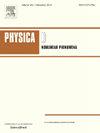The impact of a wind switch on the stability of traveling fronts in a reaction–diffusion model of fire propagation
IF 2.7
3区 数学
Q1 MATHEMATICS, APPLIED
引用次数: 0
Abstract
For certain values of the wave speed parameter, evolution equations for the temperature of a region of fuel admit traveling wave solutions describing fire fronts. We consider such a system in the form of a nonlinear reaction–diffusion equation with a first-order forcing term capturing the combined effects of ambient and fire-induced wind. The fire-induced wind is introduced by way of a piecewise continuous function that “switches” in space. We demonstrate that, in the case of a spatially dependent wind, traveling wave solutions corresponding to fire fronts exist for a continuum of wave speeds rather than for a single unique speed. Using geometric methods, we determine the range of allowable speeds, refine this range to only those fronts which will persist in nature, and develop a selection mechanism to identify the specific wind configuration corresponding to the most stable solution. For this spectrally preferred front, we find that the wind switch occurs ahead of the fireline in a manner consistent with the physics of air entrainment. Even when the wind is not coupled to the temperature and is instead imposed as an external forcing, the conditions on the existence and stability of front solutions force the wind term in to a configuration reflective of physical reality.
火传播反应-扩散模型中风转换对行进锋稳定性的影响
对于一定的波速参数值,燃料区域温度的演化方程允许描述火锋的行波解。我们以非线性反应扩散方程的形式来考虑这样一个系统,该方程具有一阶强迫项,可以捕获环境风和火致风的综合效应。火灾引起的风是通过分段连续函数在空间中“切换”的方式引入的。我们证明,在空间依赖风的情况下,火锋对应的行波解存在于连续的波速中,而不是存在于单一的唯一速度中。使用几何方法,我们确定了允许速度的范围,将这个范围细化到那些将在自然界中持续存在的锋面,并开发了一种选择机制,以确定与最稳定解决方案相对应的特定风配置。对于这一光谱优选锋面,我们发现风转换发生在火线前方,其方式与空气夹带的物理特性一致。即使风不与温度耦合,而是作为外部强迫施加,锋面解的存在和稳定性条件也迫使风项进入反映物理现实的配置。
本文章由计算机程序翻译,如有差异,请以英文原文为准。
求助全文
约1分钟内获得全文
求助全文
来源期刊

Physica D: Nonlinear Phenomena
物理-物理:数学物理
CiteScore
7.30
自引率
7.50%
发文量
213
审稿时长
65 days
期刊介绍:
Physica D (Nonlinear Phenomena) publishes research and review articles reporting on experimental and theoretical works, techniques and ideas that advance the understanding of nonlinear phenomena. Topics encompass wave motion in physical, chemical and biological systems; physical or biological phenomena governed by nonlinear field equations, including hydrodynamics and turbulence; pattern formation and cooperative phenomena; instability, bifurcations, chaos, and space-time disorder; integrable/Hamiltonian systems; asymptotic analysis and, more generally, mathematical methods for nonlinear systems.
 求助内容:
求助内容: 应助结果提醒方式:
应助结果提醒方式:


